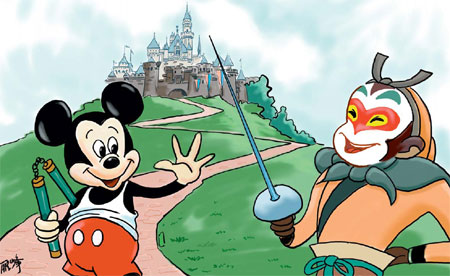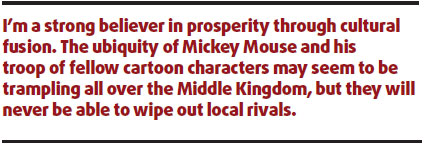
|
LIFE> Travel
 |
|
Who's taking the Mickey?
By Raymond Zhou (China Daily)
Updated: 2009-01-16 07:47
 It was announced this week that a plan to build a Disney theme park in Shanghai would be submitted to the central government for approval. If green-lighted it will be the second Disney park in China, after the one in Hong Kong, which opened in 2005. The new park is slated for 2014. Many in Hong Kong view a possible Shanghai park as a competitor, but there is a bigger picture - a threat, so to speak, to China's own theme park industry and Chinese culture in general, some argue.
I'm not exaggerating. A friend of mine, who is an expert on the theme park business, is strongly against the idea. He was educated in the United States and for the sake of anonymity I'll call him John. John was driving around the US in the 1990s, studying parks and providing consulting services to local governments and theme park developers in China. He was among the first to learn of Disney's foray into the China market, and he was the force behind several Chinese cities in their bids to lure Disney their way. They all lost to Hong Kong in the end but John was convinced that a Disney park on the mainland, anywhere, would create miracles for the local economy. Fast forward a decade. John is no longer so sure. As a matter of fact, he is positive it will do more harm than good. In his analysis, China needed Disney more than Disney needed China in the 1990s; but things are different now. China's economy has advanced so much in the past decade the equation is essentially reversed. He is now an adamant opponent of having another park in China, especially bustling Shanghai. Obviously the Shanghai municipal government did not take his advice. They are willing to give the Walt Disney Co 43 percent for the mostly intellectual properties pertaining to the theme park. Who needs whom more, especially in this era of economic uncertainty? I'm a strong believer in prosperity through cultural fusion. The ubiquity of Mickey Mouse and his troop of fellow cartoon characters may seem to be trampling all over the Middle Kingdom, but they will never be able to wipe out local rivals. People often talk about the absence of Chinese cultural images on the global stage. The Monkey King is a perennial favorite, but he has conquered part of Asia at most. He has the potential to rival the Mouse in popularity, but without a global player such as a multinational media corporation he cannot venture far from his base in China. The weakness is self-wrought. Even without foreign competition, Chinese culture in general and Chinese animation in particular is not reaching global audiences. Here lies a crucial distinction: Chinese arts and culture invariably wow foreign audiences, but they do not carry wide enough appeal to have commercial viability. To put it simply, they are good, but not popular. The trick is not just about creating great works, but about creating them consistently. How many outstanding fantasy characters have we seen since the Monkey King? None. Nothing has come close. To compete with the Disney empire we need to have a creative kingdom of our own, an army of great cartoon characters that are capable of spawning ancillary products, characters that can sustain long-running series, and new characters that reflect contemporary sensibilities. Disney does not have only Mickey Mouse, and Hollywood does not have only Disney. To spur creativity, we should give free rein to the imagination. And to make creativity endlessly profitable, we should have business people who can find or create a burgeoning market for these creations. In all these areas, Disney and its theme parks can offer us invaluable lessons. Isolation has never been good to our culture. A healthy dose of competition will only tickle us to create something as good or better. Theme parks have content. They are not just pretty to look at. In the 1990s, a homegrown industry sprouted up in China. Most of them featured miniatures of landmarks from outside China, often called World Parks, or those from ethnic minorities inside China, usually called Ethnicity Parks. (The one in Beijing, just south of the Olympic Green, was translated as Racist Park. Please don't laugh, it's not a joke.) To put it bluntly, these theme parks catered to a clientele who could not afford to visit the real scenic or historic attractions. In a sense, they are the poor man's version of a national or world tour, something like "around the world in 80 minutes". The meme of shanzhai is apt here. From the perspective of the visitor, these parks are only good as a backdrop for a photo shoot. There's little interactive function in it. Of course, Disneyland has the castle as its centerpiece, which is nothing but a scaled-down movie prop, but much of the fun derives from all kinds of rides, which are inspired by Disney movies and characters. Most of the domestic theme parks turned out to be a flash in the pan. Business was decent in the first couple of years and then attendance suffered a precipitous drop, to the point that it resembled Hearst Castle, after Hearst died but before it opened to the public. A savior materialized in the form of rising land prices, as the land used to be part of the outer suburbs but is now part of downtown. So, where is our Walt Disney, the visionary who conceived and built Disneyland in southern California in 1955? So many Chinese planners and designers have traveled the world they should have a firm grasp of the meaning of international standards. What is needed is out-of-the-box thinking - thought so unconventional that it will not just replicate the Disneyland model, but will force us to view the industry in a different light. Take the Monkey King and all the wonderful stories featured in The Journey to the West. They would make for a great theme park if you could solve all the technical difficulties. But if Disneyland can present Tomorrowland, which is not yet out of date after 53 years of operation, we should be able to take advantage of modern technologies and bring the Monkey King and his hordes to life. Moreover, we can have visitors participate in his adventures. Isn't that so much better than having a few tourists walking through an empty mud hut and having a TV screen explain Stephen Chow's mock epic of the Monkey King used this location? From a broader perspective, products of a cultural or entertainment nature tend to have a high profile and therefore are scrutinized with a stricter set of yardsticks. A Disney movie may have as much appeal, but it is not likely to be courted with as much enthusiasm as a Disney park. It is a testament to the lack of confidence on the part of some of our regulators and local competitors. When all is said and done, an international rival, no matter how stalwart, cannot serve all the needs of local audiences. Culture is about differences while a cross-cultural giant can only succeed in terms of universality.
 (China Daily 01/16/2009 page18) |